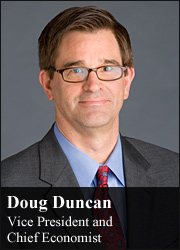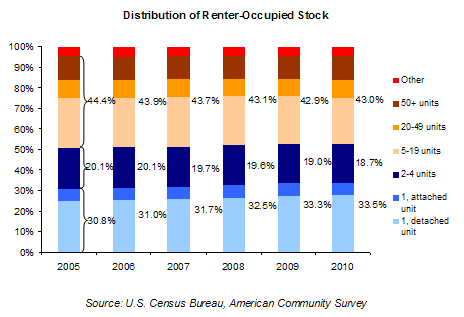Survey Shows Lenders Believe New Regulations Have Had "Significant" Impact on Their Business

The latest installment in the Data Note series from Fannie Mae’s Economic & Strategic Research Group uses American Community Survey (ACS) data from the U.S. Census Bureau to examine the recent shift toward single-family rental housing. From 2005 to 2010, single-family houses grew from 30.8 percent to 33.5 percent of rental housing units, while the share of other rental property types declined correspondingly (see chart below).
It is an opportune time to examine the data behind this tenure shift, which has and is expected to continue to have a significant impact on the housing and mortgage market. This Data Note uses recently released 2010 ACS data to investigate patterns in market share, age, income, and household size at the national level, as well as market share trends at the metropolitan statistical area (MSA) level.
Single-family renting households do not fit into the typical renting demographic. They are older and larger than households in any other rental type. While 35- to 64-year-olds make up 49.7 percent of all renting households, they account for 56.8 percent of single-family renting households. And although single-family renters have a higher median income than occupants of other rental types, their rental burden was essentially the same. For instance, 44.1 percent of single-family renters paid more than 35 percent of their gross household income in rental and utilities, compared to an almost-identical 43.8 percent of all renters.
The saying that “real estate is always local” holds for the rental sector as well as other parts of the market. Due to various factors of both supply and demand, the occurrence of single-family rentals varies greatly across the nation. The single-family house has a rental market share of above 50 percent in MSAs like Bakersfield, CA, and Stockton, CA, but below 20 percent in many MSAs in the Northeast. Many MSAs hardest hit by the recession have seen above-average growth in single-family rentership. Nationwide, single-family rentals gained 2.7 percentage points of market share from 2005 to 2010. Meanwhile, single-family rentals in the Phoenix, AZ and Las Vegas, NV MSAs gained 12.3 percentage points and 10.1 percentage points of market share, respectively.
It is clear that new demand for rental units does not translate entirely into new demand for apartment buildings. The recession, increased foreclosures, and credit tightness have helped create greater demand for a rental unit that provides the benefits of a single-family home. This Data Note sheds light on the unique characteristics of a rapidly growing market segment.

Doug Duncan
Chief Economist
Vice President
March 16, 2012
Opinions, analyses, estimates, forecasts and other views of Fannie Mae's Economic & Strategic Research (ESR) group included in this commentary and related Data Note should not be construed as indicating Fannie Mae's business prospects or expected results, are based on a number of assumptions, and are subject to change without notice. How this information affects Fannie Mae will depend on many factors. Although the ESR group bases its opinions, analyses, estimates, forecasts and other views on information it considers reliable, it does not guarantee that the information provided in these materials is accurate, current or suitable for any particular purpose and this information does not constitute investment advice. Changes in the assumptions or the information underlying these views could produce materially different results. The analyses, opinions, estimates, forecasts and other views published by the ESR group represent the views of that group as of the date indicated and do not necessarily represent the views of Fannie Mae or its management.
The views expressed in these articles reflect the personal views of the authors, and do not necessarily reflect the views or policies of any other person, including Fannie Mae or its Conservator. Any figures or estimates included in an article are solely the responsibility of the author.
